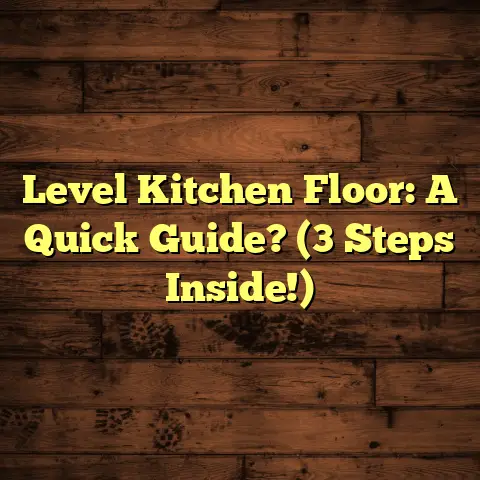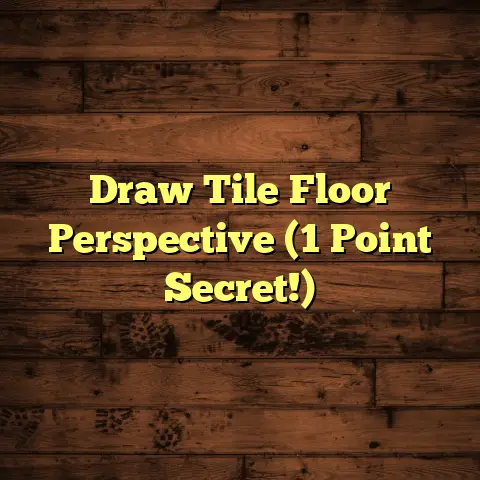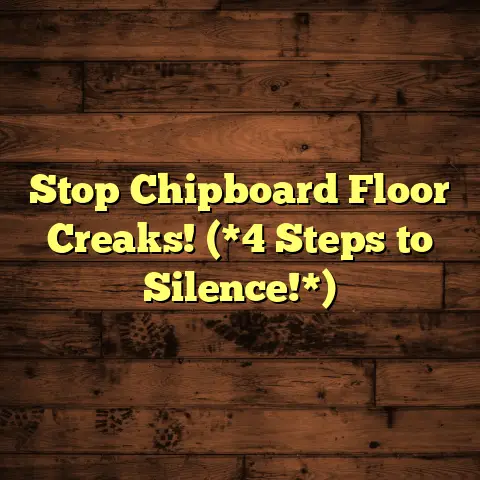Refinish Wood Floors: How Many Times? (10 Refinishes?)
Why did the hardwood floor break up with the carpet? Because it found someone who could really support it! (Okay, I know, I know… I’m a flooring contractor, not a comedian!)
But seriously, let’s talk wood floors. As a seasoned flooring contractor, one of the most common questions I get is: “How many times can I refinish my wood floors?” And often, the follow-up is, “I heard you can do it 10 times!”
Well, buckle up, because the answer is a bit more complicated than a simple number. Let’s dive into the nitty-gritty of wood floor refinishing.
1. Understanding Wood Floor Refinishing
So, what exactly does it mean to refinish a wood floor?
Essentially, it’s like giving your floor a makeover. We’re talking about removing the old, worn-out finish and applying a fresh new one.
-
The Process: This typically involves sanding down the top layers of the wood, removing scratches, dents, and old stain. Then, we apply a new stain (if desired) and several coats of protective finish (like polyurethane or a similar sealant).
-
Why Refinish? To restore the floor’s beauty, protect it from further damage, and extend its lifespan.
Now, let’s talk about the types of wood flooring you might have in your home.
-
Solid Hardwood: This is what most people think of when they hear “hardwood.” It’s made from a single piece of wood, typically ¾ inch thick. Common species include oak (red and white), maple, hickory, and cherry.
-
Engineered Hardwood: This consists of a thin veneer of real hardwood glued to a core of plywood or fiberboard. It’s more stable than solid hardwood and less prone to warping or cupping.
-
Laminate Flooring: While it mimics the look of wood, laminate is a completely different beast. It’s a multi-layer synthetic flooring product fused together with a lamination process. You can’t refinish laminate flooring.
Key Takeaway: Understanding what type of wood floor you have is crucial, as it directly impacts whether or not it can be refinished.
2. The Lifespan of Wood Floors
How long can you expect your wood floors to last?
-
Solid Hardwood: With proper care and refinishing, solid hardwood floors can last for over 100 years. Yes, you read that right!
-
Engineered Hardwood: This is a bit more variable. The lifespan depends on the thickness of the veneer. Some engineered floors can last 20-30 years, while others might only last 10-15 years.
Now, what factors influence how often you can refinish a floor?
-
Wear and Tear: High-traffic areas, pets, and kids can all take a toll on your floors.
-
Type of Wood: Harder woods like oak and hickory can withstand more refinishing than softer woods like pine.
-
Previous Refinishing Jobs: How much wood was removed during previous refinishing? This is critical!
-
Sanding Technique: An aggressive sanding job can remove a lot of wood unnecessarily, limiting future refinishing.
Think of it like this: Your wood floor has a finite amount of “meat” to it. Each refinishing job removes a little bit of that “meat.” Once you’ve sanded down to the tongue-and-groove (for solid hardwood) or the core layer (for engineered hardwood), you’re done.
3. Signs Your Wood Floors Need Refinishing
How do you know when it’s time to refinish? Here are some telltale signs I look for:
-
Scratches and Dents: Minor scratches are normal, but deep gouges and widespread scratches indicate that the finish is compromised.
-
Dullness: The floor looks lifeless and lacks its original shine.
-
Discoloration: Sun damage, water stains, or wear patterns can cause discoloration.
-
Worn Finish: The finish has worn away in high-traffic areas, exposing the bare wood. This makes the floor vulnerable to damage.
-
Cupping or Crowning: This indicates moisture problems. Cupping is when the edges of the boards are higher than the center, and crowning is the opposite.
-
Graying: Wood turning gray is a sign of water damage and sun exposure.
Let’s be real: Life happens. Foot traffic, pets (especially those with long nails!), and environmental factors all contribute to the degradation of your wood floors.
Personal Story: I once worked on a house where the owners had a Great Dane. Beautiful dog, but those nails had wreaked havoc on the floors! We ended up doing a full refinish, and I recommended they invest in some good-quality rugs.
4. How Many Times Can You Refinish Wood Floors?
Alright, let’s get to the heart of the matter: How many times can you realistically refinish your wood floors?
The truth is, there’s no magic number. It depends on several factors, as we discussed earlier.
-
Solid Hardwood (¾ inch thick): Potentially 4-6 times, if done carefully.
-
Engineered Hardwood: This is where it gets tricky. Some engineered floors can’t be refinished at all, while others can be refinished once or twice, if the veneer is thick enough (2mm or more).
Expert Opinion: According to the National Wood Flooring Association (NWFA), the number of times a wood floor can be refinished depends on the thickness of the wear layer and the amount of wood removed during each sanding.
Important Note: Each refinishing removes a portion of the wood. Over-sanding can lead to irreversible damage.
Statistics: I’ve seen estimates that suggest an average of 3-4 refinishes for solid hardwood floors over their lifespan. However, this is just an average, and the actual number can vary.
Real-World Example: I recently assessed a beautiful old oak floor that had already been refinished twice. Based on its current thickness and the condition of the wood, I estimated that it could probably handle one more refinishing, maybe two if we were extremely careful.
5. The Myth of “10 Refinishes”
Now, let’s address the elephant in the room: the myth that wood floors can be refinished up to ten times.
Where did this idea come from? Honestly, I’m not sure. Maybe it was a marketing ploy by someone trying to sell flooring services.
The Reality: In my experience, refinishing a wood floor ten times is highly unlikely, especially with today’s thinner flooring options and aggressive sanding techniques.
Data and Studies: I haven’t found any credible studies that support the claim of ten refinishes. Most experts agree that it’s an exaggeration.
Potential Risks of Excessive Refinishing:
-
Weakening the Floor: Removing too much wood can make the floor thinner and more susceptible to damage.
-
Exposing the Nails: Sanding too deeply can expose the nails used to install the floor, which is a major problem.
-
Damaging the Subfloor: If you sand through the wood, you risk damaging the subfloor, which can be costly to repair.
My Advice: Don’t get caught up in the “ten refinishes” myth. Focus on proper maintenance and refinishing only when necessary.
6. Refinishing Techniques and Their Impact on Longevity
The type of refinishing technique used can also affect the longevity of your floors.
-
Traditional Sanding: This involves using a drum sander to remove the old finish. It’s effective, but it can also remove a significant amount of wood if not done carefully.
-
Dustless Sanding: This uses specialized equipment to minimize dust. It’s cleaner and healthier, but it doesn’t necessarily remove less wood.
-
Screening and Recoating (Buffing): This is a less aggressive method that involves lightly abrading the existing finish and applying a new coat. It’s suitable for floors with minor scratches and wear. It removes almost no wood.
Finish Options:
-
Oil-Based Polyurethane: Durable and provides a rich, warm tone. However, it has a strong odor and takes longer to dry.
-
Water-Based Polyurethane: Lower odor, dries faster, and is more environmentally friendly. However, it may not be as durable as oil-based polyurethane.
-
Moisture-Cured Urethane: The most durable finish available, but it’s also the most expensive and difficult to apply.
-
Penetrating Oil Finishes: These finishes penetrate the wood and harden, providing a natural look and feel. They are easier to repair than polyurethane finishes, but they require more maintenance.
Professional vs. DIY:
While DIY refinishing is possible, I strongly recommend hiring a professional. A professional has the experience, equipment, and knowledge to do the job correctly and avoid costly mistakes.
Why Hire a Pro?
-
Proper Sanding: Professionals know how to sand evenly and avoid removing too much wood.
-
Dust Control: Professionals have the equipment to minimize dust.
-
Finish Application: Professionals can apply the finish evenly and avoid streaks or bubbles.
-
Warranty: Many professionals offer warranties on their work.
Personal Experience: I’ve seen countless DIY refinishing jobs gone wrong. From uneven sanding to bubbled finishes, the results can be disastrous. In many cases, it ends up costing more to fix the DIY mistakes than it would have to hire a professional in the first place.
7. The Cost of Refinishing
Let’s talk money. How much does it cost to refinish wood floors?
The cost varies depending on several factors, including:
-
Square Footage: The larger the area, the higher the cost.
-
Type of Wood: Some woods are more difficult to sand and finish than others.
-
Condition of the Floor: Floors with extensive damage may require more prep work.
-
Type of Finish: Some finishes are more expensive than others.
-
Labor Costs: Labor costs vary depending on your location.
General Estimates:
-
Screening and Recoating: \$1 to \$3 per square foot.
-
Refinishing (Sanding, Staining, and Sealing): \$3 to \$8 per square foot.
Refinish vs. Replace:
When is it more cost-effective to replace your wood floors rather than refinish them?
-
Extensive Damage: If the floors are severely damaged (e.g., water damage, rot, or insect infestation), replacement may be the only option.
-
Thin Veneer: If you have engineered hardwood with a very thin veneer, refinishing may not be possible.
-
Cost Comparison: Get quotes for both refinishing and replacement. Compare the costs and consider the long-term value.
Important Consideration: Replacing wood floors is a major undertaking that can disrupt your life for several days or even weeks. Refinishing is typically less disruptive.
8. Maintenance to Extend Life Between Refinishes
The best way to extend the life of your wood floors is to maintain them properly. Here are some tips:
-
Regular Cleaning: Sweep or vacuum regularly to remove dirt and debris.
-
Damp Mopping: Use a damp mop with a wood floor cleaner. Avoid excessive water, which can damage the wood.
-
Protective Rugs: Place rugs in high-traffic areas to protect the finish.
-
Furniture Pads: Use furniture pads under the legs of furniture to prevent scratches.
-
Pet Care: Keep your pets’ nails trimmed to minimize scratches.
-
Humidity Control: Maintain a consistent humidity level in your home to prevent the wood from warping or cupping.
-
Avoid Harsh Chemicals: Don’t use harsh chemicals or abrasive cleaners on your wood floors.
Cleaning Methods:
-
Vacuuming: Use a vacuum with a soft brush attachment to avoid scratching the floor.
-
Dust Mopping: Use a microfiber dust mop to remove dust and debris.
-
Damp Mopping: Use a damp mop with a wood floor cleaner.
Humidity Control:
-
Ideal Humidity: The ideal humidity level for wood floors is between 30% and 50%.
-
Humidifiers/Dehumidifiers: Use a humidifier in the winter and a dehumidifier in the summer to maintain a consistent humidity level.
Personal Tip: I always recommend using a pH-neutral wood floor cleaner. These cleaners are gentle on the finish and won’t leave a residue.
9. Conclusion
So, how many times can you refinish your wood floors?
The answer, as you now know, is: it depends. It depends on the type of wood, the thickness of the wood, the condition of the floor, and the refinishing techniques used.
Don’t fall for the myth of “ten refinishes.” Focus on proper maintenance and refinishing only when necessary.
Refinishing can rejuvenate your wood floors and extend their lifespan. But understanding the limitations and practicing proper maintenance is crucial for long-term enjoyment.
Ultimately, your wood floors are an investment. Taking care of them will pay off in the long run, both in terms of aesthetics and value.
And hey, if you’re ever unsure about whether or not to refinish your floors, give a qualified flooring contractor a call. We’re happy to assess your floors and provide you with expert advice.
After all, we’re here to help you keep your floors looking beautiful for years to come!





